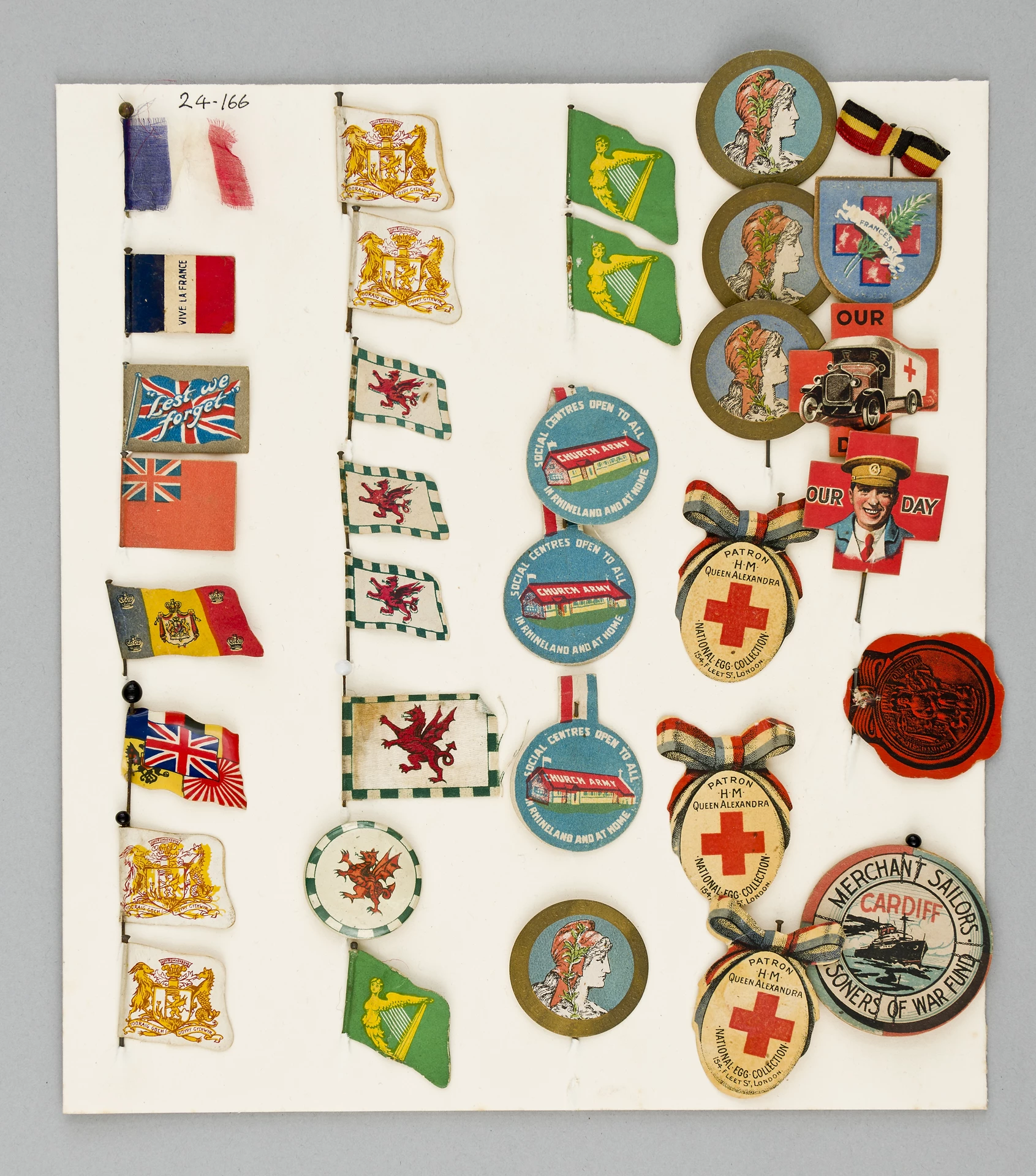WW1 flag day badges - a blog by volunteer Lydia Griffiths
, 2 June 2015
To celebrate Volunteers' Week, Lydia Griffiths, a volunteer and Youth Forum member at Amgueddfa Cymru, talks about her research into British charity and voluntary action during the First World War through studying a collection of Flag Day badges at St Fagans National History Museum.
Voluntary action made a significant contribution to the First World War, not only in the numbers of soldiers who volunteered to fight but also the civilians on the Home Front who donated food and clothing in addition to providing medical and financial support. As part of my Art History Degree at the University of Bristol, I embarked on a dissertation to research a collection of Flag Day badges at St Fagans National History Museum and discovered a fascinating legacy of British voluntary action that can be traced to the present day.
Flag Day badges consist of paper and sometimes silk flags attached to metal pins that were simple to produce and sold for as little as a penny. They tended to be sold on specific days and in addition to being easily adapted to suit any cause, they were quickly and efficiently produced offering the contributor the opportunity to display their commitments to the war effort by simply purchasing and wearing a Flag Day badge. Many thousands of volunteers contributed to the war effort by selling and producing these badges which generated an impressive amount of money. It has been estimated that during the First World War, the Red Cross alone raised £22 million - the equivalent to £1.75 billion today - which included the selling of Flag Day badges.
The collection of Flag Day badges at St Fagans could be regarded as social signifiers indicative of a nation committed to supporting and helping those in need, a trend that continues today. There are hundreds of flags in the collection and all have their own specific purpose and underlying story, such as those that reference St Dunstan’s Day, a charity based in London which was set-up to help the blinded soldiers which is still functioning today under the title Blind Veteran UK. There are also many Red Cross related Flag Day badges and some bear the words ‘Our Days’ that reference a day dedicated specifically to fundraising for the Red Cross which has been described as the equivalent to our modern day Comic Relief and Children in Need.
Personally, I found the Russian Flag Day badges featuring the symbol of the Red Cross the most inspiring as they were established by a London based Russian Petroleum Scientist, Dr Paul Dvorkovitz, who wanted to improve the allied relationship between Russia and Great Britain. The archives in the Imperial War Museum currently have all his telegrams and diaries and they reveal that he proposed the idea that British towns across the country could hold ‘Russian Days,’ where Russian themed Flag Day badges would be sold to generate funds for the Russian war effort and in return certain Russian cities would hold similar English or British Flag Days to raise funds for Britain. In Wales, Welsh newspapers from the period report that many Russian Flag Days were held in Swansea and Cardiff which is why they appear in the collection at St Fagans. Nationally the movement raised £50,000 in 1916 that prompted the Tsarina to send a telegram to The Times newspaper thanking the British for their generosity.
Since the Great War, voluntary action and charities have emerged as hugely significant assets to British society and their importance has certainly not wavered. Without the work of volunteers many institutions across the country would struggle to survive and it is interesting to note that many of today’s volunteers could be viewed simply as following in the footsteps of our ancestors from the First World War who took it upon themselves to volunteer to fight, fundraise and work to ensure a better future for their country.
Happy Volunteers Week!
LYDIA GRIFFITHS @lydiabranweng
References:
Adrian Gregory, The Last Great War: British Society and the First World War (Cambridge, 2008)
Carol Harris, '1914-1918: How charities helped to win WW1' Third Sector
Imperial War Museum Archives
Peter Grant, Philanthropy and Voluntary Action in the First World War (New York, 2014)
The Times Newspaper Archives



